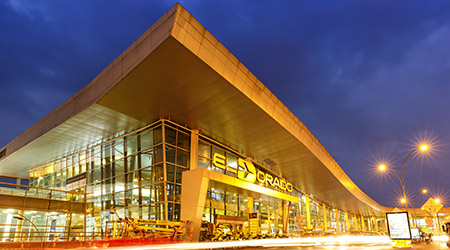
Markus Mainka / Shutterstock.com
Case Study: Airport Reduces Carbon Footprint with 3D Printed Lighting
December 3, 2021
Signify has provided the El Dorado International Airport in Bogota, Colombia, with 8,941 3D printed downlights that will help the airport to reduce its carbon emissions by using3D printed luminaire that has a 75 percent lower carbon footprint than conventionally fabricated metal fixtures. The airport also retrofitted more than 14,000 luminaires to LEDs, helping to reduce the airport’s electricity consumption by 66 percent.
3D printed luminaires allow facilities to tailor their lighting to their exact preferences. A typical 3D printed luminaire (excluding electronics and optics) has a 75 percent lower carbon footprint than a conventionally fabricated metal fixture. Signify uses a 100 percent recyclable polycarbonate material and limits the usage of screws and number of parts to simplify recycling and resulting in less weight. This in turn reduces emissions from shipping by 28 percent. Using colored materials instead of having to paint them afterwards avoids the need for additional coloring or post-processing, further simplifying the process. In addition, nearly every component may be reused or recycled, supporting the concept of a circular economy.
“Our goal is to be a benchmark in energy efficiency and sustainable operations in Colombia and Latin America. For this reason, we’re excited to have installed the latest innovation in lighting with 3D printed downlights and to be the regional pioneer when it comes to remote management of the lighting infrastructure,” says Mauricio Vélez, OPAIN's infrastructure manager, operator of the airport. The airport has recently been recognized by the US Green Building Council with the maximum LEED platinum rating - version 4.1 in operation and maintenance.
Outdoors, Signify installed Digistreet luminaires, which have been integrated with Interact, its connected lighting system and software. Interact’s lighting management dashboard enables the airport operators to remotely monitor, manage and control each light point individually, from anywhere. By having the visibility of the lighting’s status, preventative maintenance and resolution of faults can be dealt with quickly, reducing maintenance costs, improving experience and minimizing disruption to operations.
Next
Read next on FacilitiesNet












